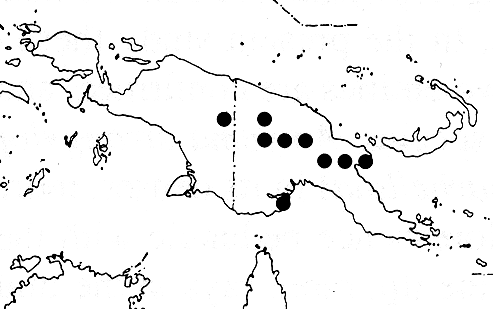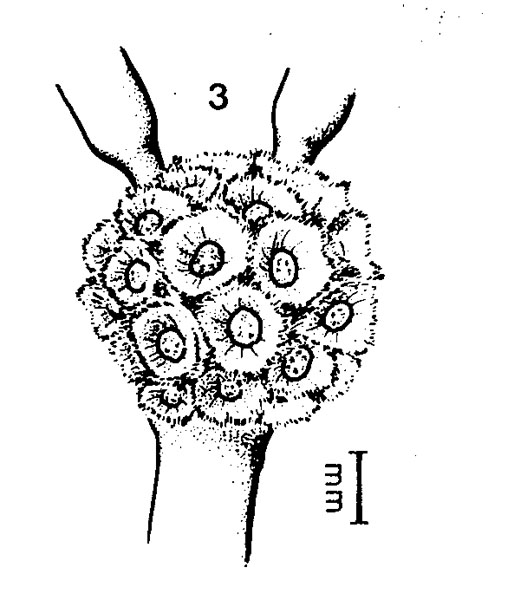
Distribution Map

Description (Barlow 1992)
Loranthus strongylophyllus Lauterbach, Nova Guinea 8 (1912) 815. - Amyema strongylophylla (Lauterbach) Danser, Bull. Jard. Bot Buitenzorg III, 10 (1929) 299. - Type: Gjellerup 307 (lecto L, see below; iso K, U 32783, WRSL).
For descriptions see Danser, Bull. Jard. Bot. Buitenzorg III,
10 (1929) 348; Barlow, Austral. J. Bot. 22 (1974) 593, under A.
strongylophyLLa subsp. strongylophylla. All additional
synonymy given by Barlow (1974) is here referred to A. rigidiflora;
see there. Amyema strongylophylla can be identified
locally by its combination of robust habit, short dense red-brown
indumentum, opposite broadly obovate to orbicular petiolate leaves,
and 15- to 20-rayed umbels of triads. The species has few specialized
characters, and thus presents a relatively generalized facies
for the genus. Flower colour is predominantly red, sometimes grading
to orange in the upper part, and partly obscured by the indumentum.
The species occurs in a limited area in northern New Guinea (fig.
15; 7 collections seen), in lowlands mostly at elevations below
300 m, and recorded once at 600 m. Habitat details are poorly
known; the only recorded host is Timonius timon.
Barlow (1974) treated both A. rigidiflora and A.
barbellata as distinct subspecies of A. strongylophylla,
but commented on their sharp differences from the typical
subspecies. In the present study these differences between A.
strongylophylla and the other two entities are confirmed,
and it is concluded that they are properly treated as distinct
species. Amyema strongylophylla differs from A. rigidiflora
(which includes A. barbellata) in its denser, more
rust-coloured indumentum, generally larger leaves, inflorescence
peduncle with the rays arising from depressions in a globular
dilation at the tip, more rays in the umbel, and longer flowers.
Amyema strongylophylla has a more restricted area than
A. rigidiflora, apparently without overlap, and occurs
at generally lower elevations.
The holotype of Loranthus strongylophyllus (B) is no longer
extant. An isotype in L has been seen and designated lectotype
of the name. Isotypes in K, U and WRSL have also been seen.
Description (Barlow 1974)
for Amyema strongylophyllum (Lauterb.)
Dans. Bull. Jard. bot. Buitenz. 10: 299 (1929); 11: 348 (1931);
Loranthus strongylophyllus Lauterb. Nov. Gum. 8: 815 (1912).
Type-New Guinea, Bivak Hollandia, 30 m alt., GIellerup
307, 18.viii.1910 (B, holotype, not seen, probably destroyed;
K; U 32783; WRSL).
Loranthus barbellatus Blakely, Proc. Roy. Soc. Qd. 34: 27 (1922); Amyema barbellata (Blakely) Dans. Bull. Jard. bot. Buitenz. 10: 294 (1929); 11: 324 (1931). Type-Astrolabe Ra., Papua, White 231, July-Aug. 1918 (Nsw).
Loranthus obtusus Krause, Bot. Jahrb. 57: 479, 480 (1922). Type-New Guinea, Finisterre Mts., 1000 m alt., Schlechter 17991, 5.vii.1908 (B, holotype, not seen, probably destroyed; K).
Loranthus rigidflorus Krause, Bot. Jahrb. 57: 465 (1922); Amyema rigidiflora (Krause) Dans. Bull. Jard. bot. Buitenz. 10: 298 (1929); 11: 344, illus. Fig. 12, d-f (1931). Type-New Guinea, Sepikgebiet, 850 m alt., Ledermann 9095 (B, holotype, not seen, probably destroyed; K).
Vegetative parts glabrous; inflorescence and flowers sparsely to densely brown- or red-brown-tomentose or the flowers rarely glabrous. Leaves opposite; petiole winged in the distal part, flat above, 0.5-1 cm long; lamina broadly ovate to orbicular, 4-13 by 3.5-11 cm, dull on both sides, abruptly attenuate at the base, rounded at the apex; venation pennate with the veins usually distinct and the lateral veins arising near the base of the lamina. Inflorescences usually several at the nodes; peduncle robust, 15-30 mm long, (l)1.5-2.5 mm thick, more or less dilated at the apex; rays 7-20, (6)-8-13 mm long; pedicels of the lateral flowers spreading, 2-4 mm long; bract erect or spreading, usually obtuse, flat, 1.5-2 mm long. Calyx cup-shaped; limb erect, 0.5-1 mm long, irregularly split. Corolla in the mature bud acute or obtuse, not clavate, (20)-25-45-(60) mm long; petals in the open flower 5 or 6, with a tuft of deflexed hairs inside at the apex, sometimes with a deflexed spur on the inside at the base. Anthers 3-5 mm long, covered in bud with deciduous appressed hairs, with a knob-like sterile tip; free parts of the filaments 4-6 mm long. Fruit cup-shaped to ellipsoidal, 5-8 mm long, crowned by the persistent calyx limb.
Occurrence. New Guinea, from Wissel Lakes to Rossel I. (Fig. 6), sea level to 2125 in altitude.
The materials examined have been placed in three subspecies with relatively distinct geographical andlor altitudinal ranges. One of these subspecies is rather distinct morphologically, while the other two tend to run into each other.
Key to Subspecies of Amyema strongylophyllum
1. Indumentum of inllorescence dense
(except sometimes for the corolla), red-brown. Leaves relatively
large (cf. species description). Rays 15-20, arising from distinct
depressions in a more or less spherical dilation of the peduncle
apex. Corolla c. 50 mm long 26a. Subsp. strongylophyllum
1. Indumentum of inflorescence
brown or yellow-brown, sparse to dense or absent. Leaves mostly
small. Rays 7-12, arising from shallow depressions in the upper
part of the dilated peduncle
apex. Corolla up to 40 mm long 2
2. Calyx tomentose 26b.
Subsp. rigidiflorum
2. Calyx glabrous 26c. Subsp. barbellatum
26a. Subsp. strongylophyllum
Indumentum of inflorescence dense (except sometimes for the corolla), red-brown. Lamina 8-13 by 5 5-11 cm. Inflorescence rays 15-20, arising from distinct depress-ions in a more or less spherical dilation of the peduncle apex. Corolla in the mature bud c. 50 mm long.
Occurrence. New Guinea, in coastal districts from the Cycloop Mts. to the Sepik River (Eig. 6), sea level to 300 m (rarely to 600 m) altitude.
Representative Specimens. WEST IRIAN: Makanoi Ra., Cycloop Mts., N. of Kotanica, 600 m alt., van Royen and Sleumer 6265, 20.vii.1961 (L; CANB). EASTERN NEW GUINEA: Sanguetti-Etappe, 300 m alt., Schlechter 18913, 3.xii.1908 (UC).
The typical subspecies is rather sharply distinct from the other two, and no intermediate specimens have been seen. There is a clear altitudinal separation from the contiguous subspecies, rigidiflorum.
Illustrations

Many-rayed umbel of triads, the basal portions
of two shown. Kalkman BW 3426, L. From Kuijt (1981)
Photographs
Amyema strongylophylla
updated 18 January 2007